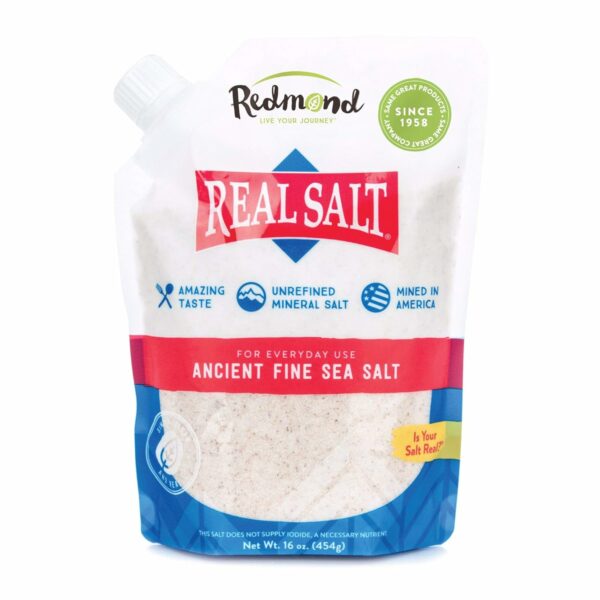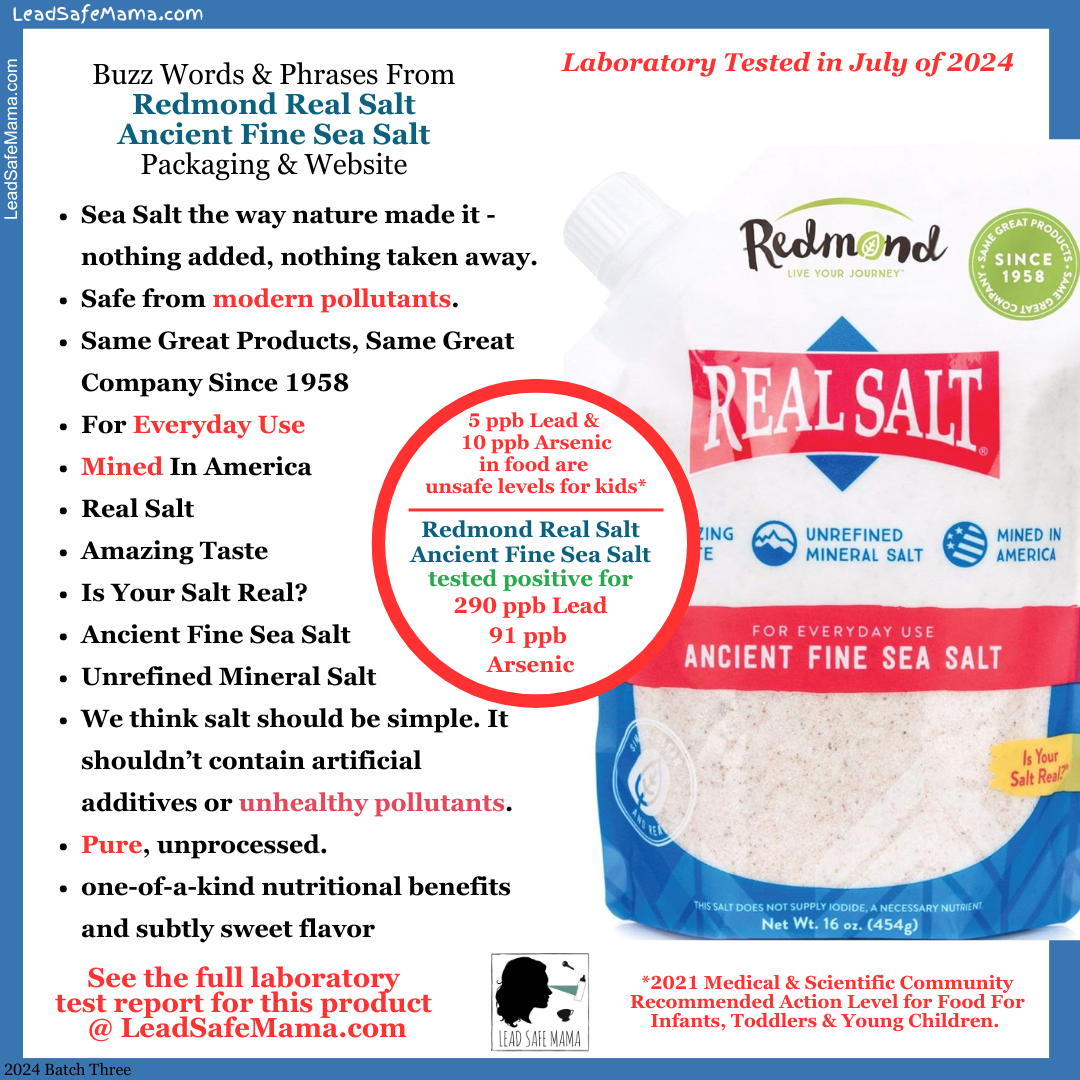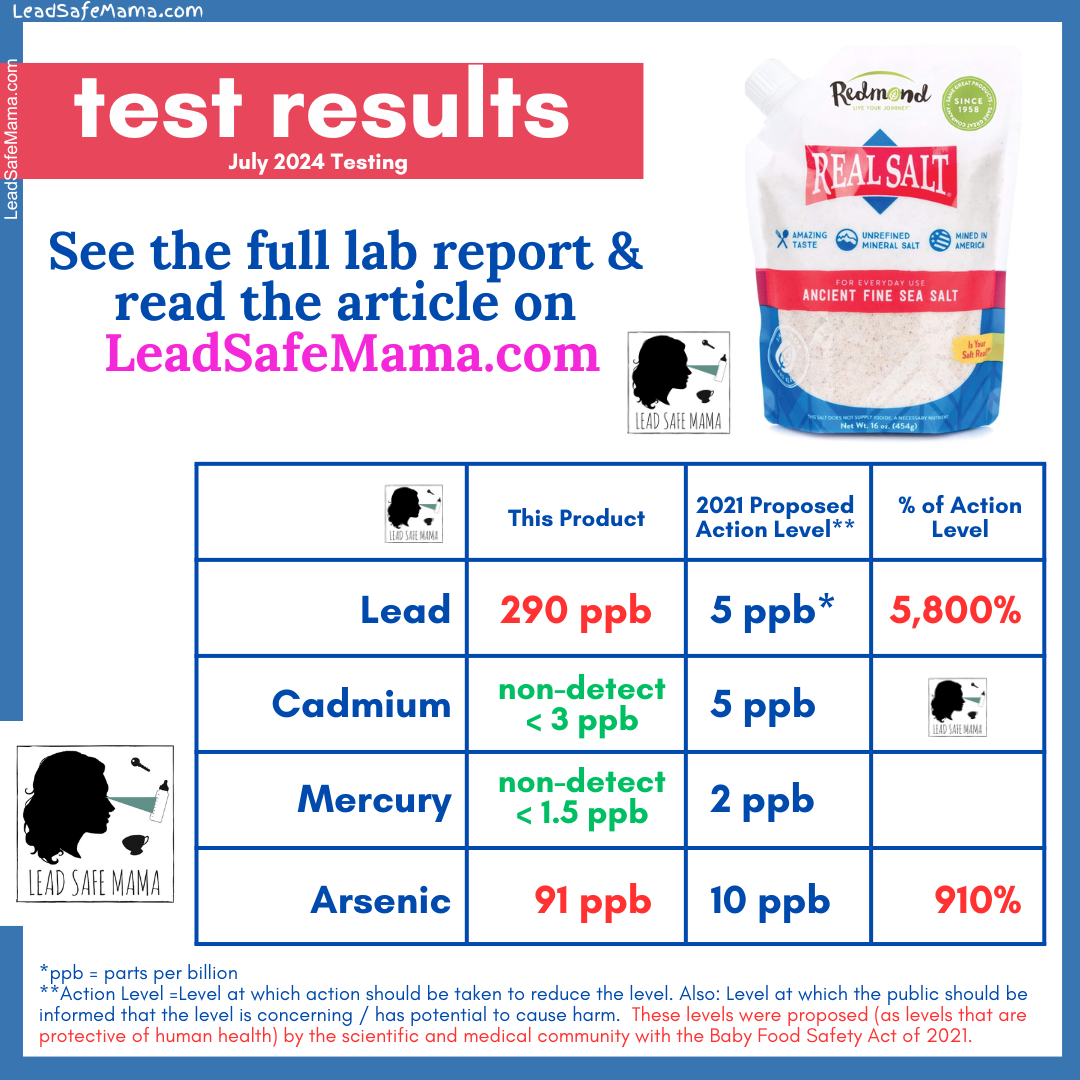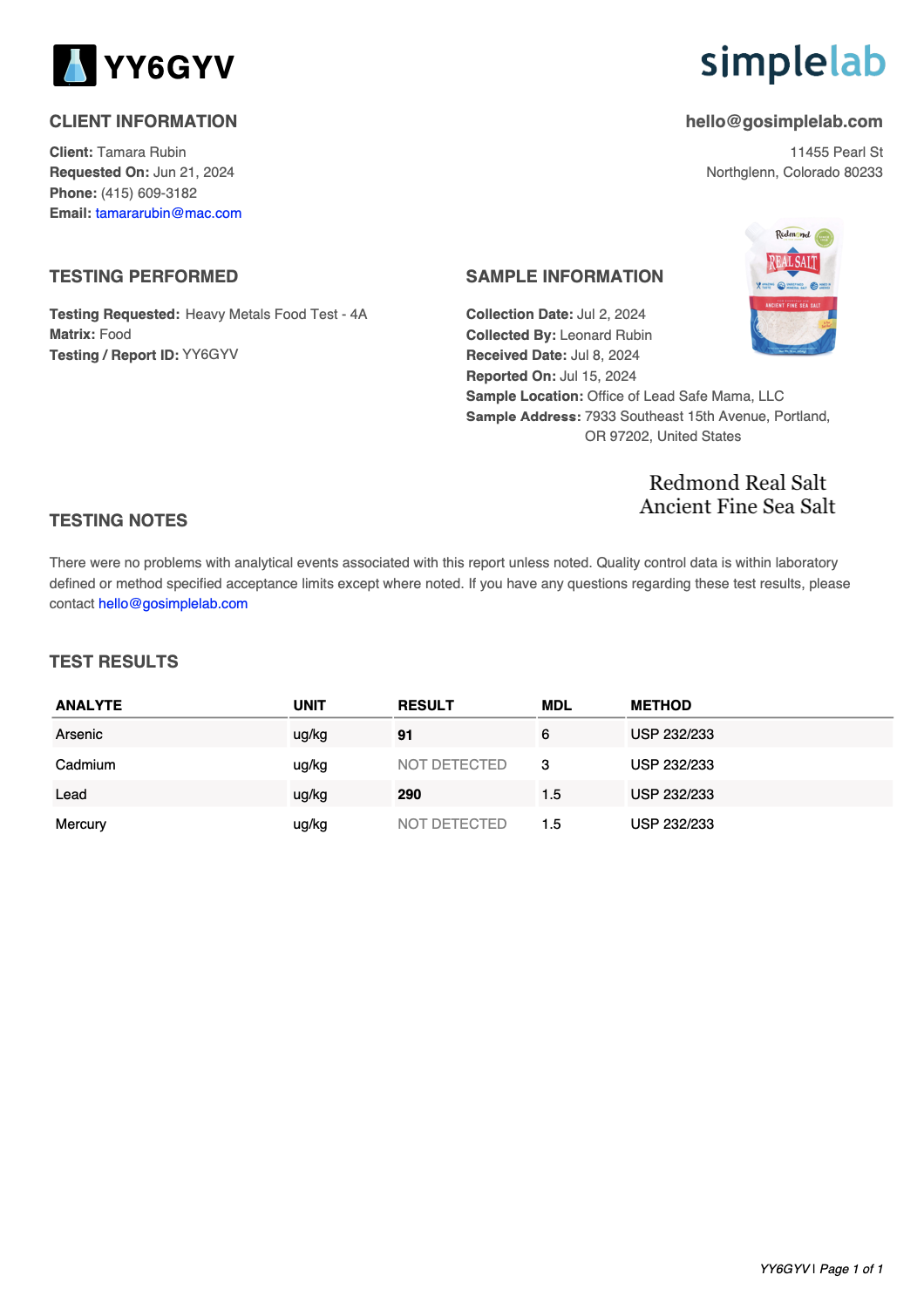Independent Third-Party Laboratory Testing Confirms Redmond Real Salt Tests Positive for Unsafe Levels of Lead and Arsenic (July 2024)

For those new to the Lead Safe Mama website:
Tamara Rubin is a multiple-federal-award-winning independent advocate for childhood Lead poisoning prevention and consumer goods safety, and a documentary filmmaker. She is also a mother of Lead-poisoned children (two of her four sons were acutely Lead-poisoned in 2005).
- Tamara owns and runs Lead Safe Mama, LLC — a unique community collaborative woman-owned small business for childhood Lead poisoning prevention and consumer goods safety.
- Since July of 2022, the work of Lead Safe Mama, LLC has been responsible for five product recalls (FDA and CPSC).
- All test results reported on this website are science-based, accurate, and replicable.
- Please check out our press page to see some of the amazing coverage of our work so far this year!
Affiliate link to the test kit Lead Safe Mama, LLC uses for the laboratory food test results we publish: https://amzn.to/3UIPcHP
This is an ad-free article.
Advertising and affiliate income help Lead Safe Mama, LLC cover the costs of the work we do here (independent consumer goods testing and childhood Lead poisoning prevention advocacy). We have removed ads from most of our more widely-read articles (and newly published articles, too — like this one!) to make them easier for you to read. In addition to supporting this work by starting any shopping you might be doing with a click on our affiliate links, if you would like to support the independent consumer goods testing and childhood Lead poisoning prevention advocacy work of Lead Safe Mama, LLC by making a contribution (which will also help us keep our more widely-read articles ad-free), click here. Thank you!
Important Background: What is an Action Level?
Please note the following key points.
The original/ full laboratory report for this product is below (at the bottom of this page).
The graphic above shows the levels of metals detected in this product (in red) along with the low threshold of detection (in green) for each of the metals not detected with the laboratory testing that Lead Safe Mama, LLC had completed for this product. The numbers are juxtaposed to (in blue) the “Action Level” proposed by the medical and scientific community in 2021 as part of the Baby Food Safety Act.
- These levels were set as “Action Levels” because they are (in fact) protective of human health.
- An “Action Level” is NOT the same as a “Maximum Allowable Level.”
- Once the level of a heavy metal in food reaches the “Action Level,” that metal is officially over any safe threshold and into the realm of heavy metal levels that can cause lasting harm to children.
- The “Action Level” is the level at which the scientific and medical community believes the company (or government) needs to take ACTION to fix the problem (which also includes taking ACTION to inform the public that the product has an unsafe level of the metal detected at-or-above the “Action Level” — and which relevant batch numbers should be recalled/ not consumed).
- These Action Levels are not arbitrary, however they were not passed into law.
- These Action Levels reflect the current advice of the medical and scientific communities as levels both achievable and also protective of infant and toddler health — regardless of the fact it is not illegal to have food for children test positive at these levels (as the Baby Food Safety Act of 2021 was never passed into law).
- The legitimacy of these levels as “Action Levels”/ “Levels of Concern” (even though they were not adopted as law) is similar to the legitimacy of the America Academy of Pediatrics’ level of concern for Lead in water — which is 1 ppb — even though the FDA’s official “level of concern” for Lead in water is 15 ppb (you can read more about that here).
For safer food choices, click here.
If you are new here, please check out our website menu (link) to see all the other types of items we have tested and reported on! Welcome to our site!
Published:
July 18, 2024 — Thursday
Here’s the link to a safer salt (which we are also testing independently):
https://amzn.to/3Sfm8r0
- The Redmond Real Salt Ancient Sea Salt (“Mined in America”) pictured in this article tested positive for levels of Lead and Arsenic that are unquestionably unsafe for children to consume (given the context of the standards proposed by the scientific and medical communities with the Baby Food Safety Act of 2021 — linked here).
- We have been writing about concerns with the Redmond brand generally — and more specifically for Lead-contamination in their full product range — for about a decade now.
- This is a link to our salt overview article (published in 2020), which is a researched summary of reported test results for many brands and types of salt (Note: this is not a summary of salts that have been laboratory tested by Lead Safe Mama, LLC, as we only started doing food testing in March 2024).
- This is the salt I have chosen to use for my family (for the reasons outlined in this article — link).
- This is a link to the lab report for (and discussion regarding) the only other salt product that Lead Safe Mama, LLC has tested to date using laboratory testing.
Considerations: “But you only consume a small amount of salt, so these levels don’t matter.”
A common refrain when it comes to substances that one consumes in smaller amounts (like salt and spices) is that the Lead content of these products is “not a problem” because only a “small amount” of the particular type of food item is consumed, and therefore a very small amount of Lead.
The (predictable) set of considerations often set forth along with this argumentation include the following: That the Lead found in the product is “naturally occurring,” that the level of Lead in the product is “unavoidable,” or that “peaches and pears” also have similar amounts of Lead as the product in question (or even the ridiculous assertion that peaches and pears have MORE Lead than the product in question)! Some even suggest that the “type of Lead” found in the particular product is a “safe form of Lead.” (!!!) Of course NONE of these considerations are true.
- There is no safe level of Lead exposure. Period.
- There is no safe form of Lead. Period.
- Modern fresh fruits and vegetables do not typically test positive for Lead at levels anywhere near the levels found in this salt product.
- Lead bioaccumulates in the body and it is the impact of total aggregate lifetime exposure that causes significant harm (especially if there is a persistent/ regular/ chronic low-level source of exposure). You can read more about that here.
- Lead-safe (lower Lead) and Lead-free alternate product choices are readily available (and therefore “safe-er” levels of Lead in this type of product are achievable/ possible).
- Taking all of the above into account, the level of Lead contamination in this particular product is not something to be dismissed.
- If you can choose a safer product (a Lead-free or at least lower Lead product), you should.
- If you (as a consumer) knew that a product had unsafe levels of Lead, it is very likely that you would choose another/ alternate/ safer product.
- As a result, the manufacturer’s dismissive statements regarding the Lead in their products are misleading and causing their customers (and especially their customer’s children) potential harm.
Why is Redmond Salt contaminated with such high levels of Lead?
While we cannot know for sure what the source of Lead contamination is for this particular salt (without visiting their facility and observing their manufacturing and mining operations), we have at least a couple of theories that are possible and/or likely:
- Given this is a mined salt product (dug out from under the earth) there is a likelihood that at least some level of contamination of the finished product is possible (and may be unavoidable) from the actual mining processes used to extract the salt.
- In addition to Lead contamination possible from Lead-painted mining equipment (and other mining/ extraction equipment that may have Leaded components, including but not limited to Leaded brass components), some types of mining operations use explosives — explosives often contain at least traces of Lead.
- Outside of possible Lead-contamination from mining techniques and mining equipment, mined minerals coexist in the earth along with other minerals. While Lead was not historically found on the surface of the earth, it is found underground and it is also a mined mineral. Depending on the depth of the Redmond “salt mines,” it is not unreasonable to assume that some of their Lead contamination could be coming from the presence of Lead in the mines where they are extracting the salt.
- Separately, we did some XRF testing of the soil in Utah when we were there last and confirmed high (XRF detectable) levels of Arsenic in the soil (unusual for soil in general, but anticipated in Utah given the research completed to date in the Great Salt Lake area). As a result, it is reasonable to assume the Arsenic is a natural contaminant of the soil in that area (although we have not yet seen any studies discussing the potential depth of Arsenic contamination in Utah-based soil).
- This is important to note: Just because a “mineral” or element (like Lead or Arsenic) is “natural” in the ground does not mean it should be allowed in our food.
- Unfortunately, the levels of Lead and Arsenic we found in this product are currently in no way illegal.
The greenwashing this company engages in, as related to their salt products:
The most profoundly concerning statements by this company are highlighted in red in the image above.
- Pollutants: They state that the product is “safe from modern pollutants” and they imply that their product does not contain any “unhealthy pollutants.” Lead is by definition both a modern pollutant and an unhealthy pollutant. While Lead has existed forever, it has only entered our food sources in more modern times (starting c. 2000 years ago) and — reiterating what is stated above — there is no safe level of Lead or safe type of Lead. All Lead is inherently unhealthy for humans — especially for human consumption (as a contaminant of any item that might be ingested).
- Pure: Redmond states that the product is PURE and unprocessed. Given it tests positive for Lead — an issue which the company has stated they are fully aware of — it is by no means “PURE.” The fact that our independent, third party testing found this salt to test positive for Arsenic at an unsafe level also challenges their assertion of “purity.”
- Everyday use: Given the level of Lead found in this salt, the fact that they are also marketing this product to be used daily is quite alarming — again noting specifically the scientific community’s well researched/ documented concern for persistent, chronic, daily exposure to Lead and the fact that this type of Lead exposure will cause the Lead to build up in your system over time, contributing to a host of long-term negative health impacts that have been well documented as associated with chronic low level Lead exposure (including: Increased risk of heart disease, infertility, kidney failure, arthritis, memory impairments, birth complications, and more).
- Sweet flavor: Ironically, their language includes the fact that this salt has a subtly sweet flavor. While the following statement is only an hypothesis (not a definite fact as it relates to this specific product), it is important to know that Lead often tastes sweet and it is very possible that the Lead contamination of the product is imparting this sweet flavor mentioned in their marketing materials.
This brand also alleges that consuming their Real Salt Ancient Sea Salt Product imparts benefits (“nutritional benefits”) from the presence of trace “beneficial minerals.” We have written two separate articles about the “myth” of “beneficial trace minerals” in otherwise Lead-contaminated salt. To be clear, in these articles we are not suggesting that people should not consume salt, we are only advocating for consumers to make informed choices based on science (for their salt as well as for any products they consume or use with food).
People should choose safer products when possible, and not blindly believe the marketing hype of products or others selling those products (especially if people selling the products are being dismissive of toxicant concerns or if third party sellers are parrotting statements about internal corporate test results for specific products without a critical analysis of those statements and/or test results).
Our recommendation in response to this and other testing we have done:
- Do not consume mined salt.
- Do not consume salt harvested in clay beds.
- Do limit your use of added salt (as modern humans, we get a lot more salt in our diet than our ancestors used to).
- Do research salt and choose a non-mined sea salt that is confirmed to be low in toxicants (based on independent, third-party testing).
Some additional reading & links that may be of interest:
- Check out our link with a spreadsheet showing all of our food testing — completed and in-progress (since March 2024).
- This is the Lead Safe Mama affiliate link to purchase the same test kits we use for this testing.
- Here’s our landing page with links to all our results for the food products we have tested.
- Here’s how to send your own food samples into a lab for testing (the cost is $195 per single food sample tested for Lead, Cadmium, Mercury, and Arsenic) or how to collaborate with Lead Safe Mama, LLC on the food testing we’re hosting.
- And, you can find more info from the Food category of articles here on Lead Safe Mama dot com.
Amazon links are affiliate links. If you purchase something after clicking a Lead Safe Mama, LLC Amazon affiliate link, we may receive a percentage of what you spend at no extra cost to you.
Never Miss an Important Article Again!
Join our Email List









Good to know. Terrible, but good to know. Seems in line with what was found for this salt by [redacted] (independent, down to ppb) testing as well, so that’s disturbingly reassuring.
I say this because I’m wondering about the consistency of toxins findings in batches. I don’t want to get attached to a salt that tests well one time then tests horribly for the next batch. So again, reassuring. Sort of.
Ive tried Jacobsen salt but find it hard to use (mega, Uber-sized flakes). Its also very expensive, so I’m looking for an alternative.
Thank you for doing this testing. It’s informative, if alarming. I hope some day you might test maple syrup, since you’ve mentioned you avoid it, expecting high lead. Though I notice others say harvesting methods have changed.
Thank you for commenting. Jacobsen’s has different types of their Oregon Sea Salt: https://amzn.to/3Ws4va8
What brand of salt is safe , i am ho estly discourage that what we consume seems unsafe at all levels!
https://tamararubin.com/2024/07/june-2024-laboratory-test-results-for-jacobsen-salt-co-pure-kosher-oregon-sea-salt/
So terrifying and disappointing. My husband and I drink their electrolytes daily and sea salt in our food every day so awful that these smaller companies trick us into thinking that they have better products than the bigger companies. What do we do with our products from redmond?
Grateful is the concept I have for all who are participating in the testing and discussion. We can and must further the sharing of our knowledge, understanding and wisdom. I’ve already and am continuing to discuss with the maker of a sauerkraut the lead and arsenic presence in Redmond’s salt. The cofounders are now discussing the problem, and we all are searching now for a clean and affordable salt to use in raw organic sauerkraut and other such fermentation products, including fermented pickles. Kimchee is another popular affected fermentation which absolutely traditionally requires salt. Micro- and nanoplastics are a relatively new complicating factor.
Thank you for your involvement.
Redmonds sells salt for livestock too. I have their salt for my goats
I switched to mined salt in order to avoid microplastics that are in sea salts.
Sooo what’s worse? Microplastics or lead & arsenic?
I believe Jacobsen screens and filters for microplastics.
May I propose you test some of the salts that are on your safe list (Jacobsen, Saltwerks, anything more affordable?)? Since many of us are looking for alternatives and likely buying these, it would be good to be sure of their numbers. I noticed that there is one brand of big chunks of himalayan salt that is also on your safer list. Could the grinding equipment be part of the problem and if so, maybe finding larger chunks of himalayan salt and grinding ourselves could be an option? Again, would be good to get a test of that as well. I think because so many salts are high in lead, we all need (ideally affordable) alternatives that we can be sure of so I think a lot of us might be interested in testing those. Also, I know you disagree, but many of us want the other minerals that come with some of these salts, so (if such a thing exists), a low lead himalayan salt would be a great option for many people I think. I know I would be happy to buy big chunks and grind if I can, if I can get the other minerals without the lead. Thank you again!
Hi Liz – some more thoughts on choosing a salt (in case you have not read this article):
https://tamararubin.com/2019/12/asktamara-what-kind-of-salt-do-you-use-in-your-kitchen/
T
This is all so overwhelming And haven’t seen much about why the Jacobsen sea salt or sea salt in general is better in regards to the toxins and microplastics in the water, except that they screen for micro plastics. I’m sure there’s many other studies that can be done to test for other harmful chemicals and toxins. I really wish the government wasnt so corrupt and we can have legit studies testing everything that can be tested and finding the safest possible salt to use.
I need a good safe salt to use to make saline solution and also for cooking
I personally am very confident in the choice of Jacobsen’s Oregon sea salt for my family. It is still the cleanest salt we have tested – although we have more at the lab right now.
At 290 ppb of lead, Redmond salt is well below the European limit for lead in most salt of 1,000 parts per billion (1.0 ppm). Yet your salt testing uses the US 2021 proposed action level of 5.0 ppb. Knowing that European safety standards are often stricter than US, why such a huge difference?
Safety standards for kids. vs. safety standards for adults.
T
Hi Tamara – what is the American safety standard for adults? Also, in what quantity of Redmond’s Real Salt is 290 ppb of lead is found? Thanks for all of your wonderful work!
Has Jacobsen ever paid you to positively advertise their product on your site?
No. Never. They have never even responded to my emails when I have asked them questions – lol!
Have they paid you?
T
I hate to hear this about Redmond Salt. I really liked it, but I am glad I know this now. I guess I will go back to using Morton Salt or Pink Himalayan Salt
How many tests were run for Redmond’s? How many different batches over what time period?
Our test results match their test results nearly exactly. I don’t know how many tests they have done.
How many tests did you run?
I read on the website they report only the highest results that they have tested, though they also find some batches have zero lead. Did you find a similar distribution?
I find this so interesting as I just was tested for a number of heavy metals in my recent thyroid lab and my arsenic levels were twice the safe levels and indicate acute and chronic exposure to high levels of arsenic. I eat no brown rice, my water is reverse osmosis, I eat very little shellfish and chicken where I live does not have arsenic issues. I also eat a whole foods diet and life an intentional healthy lifestyle so my report was a shock. The only thing I can currently trace my high arsenic to is the fact I have used Redmond Real Salt every day for the last 5 years and even use it in my water for electrolyte balance. If it wasn’t for your report I wouldn’t have known about the unsafe levels of lead and arsenic in this salt. The lab I took didn’t test for lead unfortunately but I will be running some additional labs to monitor. Thank you for your diligence and sharing your findings. Although I cannot say 100% that my high arsenic is due to this salt I would say it’s sure pointing to it and I’ve stopped using it that’s for sure !
Thank you for commenting.
T